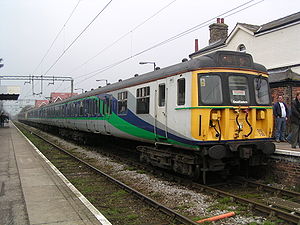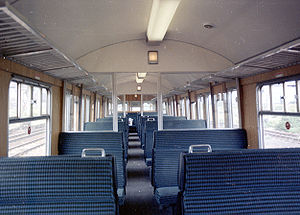Our website is made possible by displaying online advertisements to our visitors.
Please consider supporting us by disabling your ad blocker.
British Rail Class 312
This article needs additional citations for verification. (January 2008) |
| British Rail Class 312 | |
|---|---|
 First Great Eastern Class 312 at Kirby Cross in 2004 | |
 Inside a Class 312 unit before refurbishment | |
| In service | 1975–2004 |
| Manufacturer | British Rail Engineering Limited |
| Order no. |
|
| Built at | Holgate Road, York |
| Family name | BR First Generation (Mark 2) |
| Replaced | Class 125 |
| Constructed | 1975–1978 |
| Number built | 49 |
| Number preserved |
|
| Successor | |
| Formation |
|
| Diagram | |
| Fleet numbers |
|
| Capacity |
|
| Operators | |
| Depots | |
| Specifications | |
| Car body construction | Steel[2] |
| Train length | 256 ft 8+1⁄2 in (78.245 m)[3] |
| Car length |
|
| Width | 9 ft 3 in (2.82 m)[2] |
| Height | 12 ft 4+1⁄2 in (3.772 m)[2] |
| Floor height | 3 ft 9 in (1.14 m)[2] |
| Doors | Hinged, manually operated ("slam")[3] |
| Wheelbase |
|
| Maximum speed |
|
| Weight |
|
| Traction motors | 4 × English Electric 546A[4][5] |
| Power output | 1,080 hp (810 kW)[3] |
| HVAC | Electric heating[2] |
| Electric system(s) |
|
| Current collector(s) | Pantograph |
| UIC classification | 2′2′+Bo′Bo′+2′2′+2′2′ |
| Bogies |
|
| Minimum turning radius | 231 ft 0 in (70.41 m)[2] |
| Braking system(s) | Electro-pneumatic[2] |
| Safety system(s) | AWS[2] |
| Coupling system | Drop-head buckeye[6] |
| Multiple working | Within class, and with Class 310 |
| Seating | Transverse |
| Track gauge | 1,435 mm (4 ft 8+1⁄2 in) standard gauge |
The British Rail Class 312 alternating current (AC) electric multiple units (EMUs) were built between 1975 and 1978[7] for use on outer-suburban passenger services. It was the last class of multiple unit to be constructed with the British Rail Mark 2 bodyshell, as well as the last class of multiple unit to be built with slam doors in Britain. These features contributed to their relatively early withdrawal at 25–28 years old, compared with a typical EMU life expectancy of 30–40 years.
- ^ a b Longworth 2015, pp. 73–74, 144, 169–170, 199, 204
- ^ a b c d e f g h i j k l m n o "Vehicle Diagram Book No.210 for Electrical Multiple Units (including A.P.T.)" (PDF). Barrowmore MRG. BRB Residuary Ltd. ED212, ED213, ED214, EE305, EF213, EH209. Archived from the original (PDF) on 3 March 2016. Retrieved 25 February 2016.
- ^ a b c d e "Class 312". The Railway Centre. Archived from the original on 14 October 2007. Retrieved 25 February 2016.
- ^ a b Fox 1987, pp. 56–57
- ^ Swain 1990, p. 58
- ^ System Data for Mechanical and Electrical Coupling of Rail Vehicles in support of GM/RT2190 (PDF). London: Rail Safety and Standards Board. 22 June 2011. p. 4. SD001. Archived from the original (PDF) on 1 April 2012. Retrieved 22 November 2022.
- ^ Marsden 1982, p. 42
Previous Page Next Page


